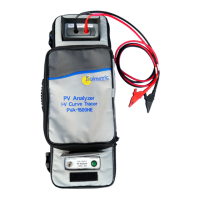Interpreting Measured I-V Curves
7-110
A normal I-V curve has a smooth shape with three distinct regions as shown in the figure above.
1. A slightly sloped horizontal leg of the curve
2. A steeply sloped leg of the curve, often informally referred to as the ‘vertical’ leg
3. A ‘knee’ in the curve between these two regions
In a normal curve, the three regions are smooth and continuous. The shape and location of the knee
depends on cell technology and manufacturer.
The three PV model points are defined, from left to right, as follows:
1. Isc – First point, at the predicted short circuit current Isc
2. MPP – Second point, the predicted maximum power point Imp, Vmp
3. Voc – Third point, at the predicted open circuit voltage Voc
Interpreting I-V Curves
PV module or string performance problems will cause deviations between the measured and predicted
I-V curves. There are six distinct types of deviation, listed below and in the following figure. A given
PV source under test may show no deviation, one deviation, or a combination of two or more
deviations.
1. Notches or steps
2. Low current
3. Low voltage
4. Rounder knee
5. Steeper slope in horizontal leg
6. Less steep slope in vertical leg

